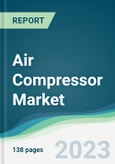The air compressor market is anticipated to expand at a CAGR of 4.48% to reach a market size of US$47.412 billion in 2028 from an initial value of US$34.882 billion in 2021.
Air compressors are machines designed to store compressed air by reducing its volume and increasing its pressure inside a tank or cylinder. These machines are commonly used across various industries and applications to generate pressurized air for powering pneumatic tools, machinery, and equipment. The air compressor market is quite extensive and diverse, catering to a wide range of customers with different needs and requirements. As industrialization continues to expand globally, there is a rising demand for compressed air in manufacturing processes.Increasing Infrastructure Investments
increased infrastructure investments, technological advancements, growing awareness about energy efficiency, etc. are some of the factors that will lead to the growth of the global air compressor market. For instance, in August 2022, the Chinese government announced that they will make around US$ 1 trillion of government funds available for construction projects. Similarly, in September 2021, the UK government announced that around £31 billion is expected to be spent on social and economic infrastructure in the coming years.Expanding Construction Industry
The construction sector heavily relies on compressed air for a wide range of applications, making air compressors essential tools in their operations. The construction industry is involved in building and developing infrastructure, such as roads, bridges, buildings, airports, and more. These projects require compressed air for various tasks like pneumatic drilling, cutting, nailing, and painting, among others. With so many advantages, the growing construction industry acts as a growth driver for the air compressor market. According to the National Statistics Office, the total construction output in the UK increased by 3.7% in December 2022. Similarly, according to the U.S. Census Bureau, the total construction spending in the country in 2022 was estimated to be nearly US$ 1, 809.8 billion. This was a 7.7% increase from 2021.Increasing Manufacturing Activities
It is widely used source of power in manufacturing, powering a variety of equipment and machinery in industrial plants. It offers flexibility and reliability, making it ideal for manufacturing processes that demand high speed, precise control, and productivity. According to data from the World Bank, the worldwide manufacturing value added has risen from US$ 12.33 trillion to US$ 16.05 trillion between 2015 and 2021, and the proportion of this value added to the GDP has increased from 16% to 17% during the same period. Thus, as global construction and manufacturing activities continue to increase, the growth of the air compressor market will also increase.Asia Pacific is Expected to Grow Significantly
The growing industrial growth in the region coupled with product innovations and launches of air compressors are majorly driving the overall market growth in the region. India’s growing investments in the automotive sector to propel overall productivity coupled with booming demand for fuel-efficient vehicles have provided a positive scope to the market outlook of air compressors in the country. According to the International Organization of Motor Vehicle Manufacturers, India’s automotive production in 2022 stood at 5.45 million units which represented a 24% increase over 2021’s production figure of 4.39 million units.Key Market Developments
- in May 2022, ELGi launched a diesel-powered “PG 575-255” and an electric-powered “PG 110E-13.5” air compressor at EXXCON 2022 (Bengaluru, India).
Segmentation:
By Type
- Positive Displacement
- Dynamic
End-User
- Automotive
- Construction
- Medical & Healthcare
- Agriculture
- Others
By Geography
- North America
- USA
- Canada
- Mexico
- South America
- Brazil
- Argentina
- Others
- Europe
- Germany
- UK
- France
- Spain
- Others
- Middle East and Africa
- Saudi Arabia
- UAE
- Others
- Asia Pacific
- China
- Japan
- South Korea
- India
- Australia
- Others
Table of Contents
1. INTRODUCTION
2. RESEARCH METHODOLOGY
3. EXECUTIVE SUMMARY
4. MARKET DYNAMICS
5. AIR COMPRESSOR MARKET, BY TYPE
6. AIR COMPRESSOR MARKET, BY END-USER
7. AIR COMPRESSOR MARKET, BY GEOGRAPHY
8. COMPETITIVE ENVIRONMENT AND ANALYSIS
9. COMPANY PROFILES
Companies Mentioned
- Atlas Copco AB
- Ingersoll Rand
- Siemens AG
- Hitachi Group
- Kaishan USA
- Sulzer Ltd.
- Dewalt
- Kobelco Compressor Corporation
- Doosan Portable Power
- Elgi Equipments
Methodology

LOADING...
Table Information
| Report Attribute | Details |
|---|---|
| No. of Pages | 138 |
| Published | October 2023 |
| Forecast Period | 2021 - 2028 |
| Estimated Market Value ( USD | $ 34.88 Billion |
| Forecasted Market Value ( USD | $ 47.41 Billion |
| Compound Annual Growth Rate | 4.4% |
| Regions Covered | Global |
| No. of Companies Mentioned | 10 |









